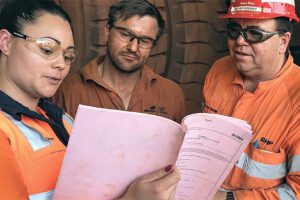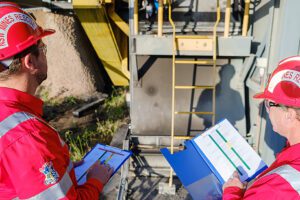Last week Fortescue Metals Group (FMG) announced that a range of additional Komatsu and Caterpillar mining trucks will move to autonomous system technology and, it is apparent that more and more mining operators are embracing the autonomous mining truck revolution.
CIMIC said that it will install automation in around 65 Komatsu 930E and Caterpillar 789D trucks at FMG’s Christmas Creek operations, along with a broad range of ancillary equipment across the miner’s Chichester hubs. The project is expected to be completed over an eighteen month period.
The project proponents expect to bring significant benefits in terms of safety and productivity to the Christmas Creek operations who, over the years, have been plagued with a range of high profile mining safety incidents.
It’s certainly a big spending commitment and FMG are hoping to get the tangible benefits from the automation but, there’s a range of perspectives across the industry on the limitations of automation and automations impact on safety.
Many investors in the automation technology have recognised that with the gains also come some losses.
There’s an old Buddhist proverb that goes “In each loss there is a gain, As in every gain there is a loss and with each new ending comes a new beginning” and it might just also apply to mining automation.
Proponents of automation have come to terms with examining the downsides to automation and the limitations in respect of productivity and safety.
Experts claim substantial productivity advantages
Experts have previously claimed that productivity and safety gains with autonomous haulage are substantial. Professor John Meech,† a former Professor of Mining Engineering at the University of British Columbia and a past leading thinker in mining automation, have said that the benefits of these autonomous hauling systems include:
- Increase of 15 to 20 percent in output;
- Decrease of 10 to 15 percent in fuel consumption;
- Decrease in tire wear by 5 to 15 percent;
- Increase in truck up-time by 10 to 20 percent;
- Decrease in maintenance by 8 percent.
There are productivity limitations
James Petty, a Consultant, iTi Solutions highlighted some of the potential productivity limitations in his article for AUSIMM Bulletin.
“Bill Gates said that, “automation magnifies both good operations and bad operations.”
The key to getting a great result from autonomous fleets is to have a well-operated site.
Autonomous fleets will not compensate for poor operations and they cannot be used to ‘buy’ good operations.
Getting expected autonomous fleet results often requires a business transformation – a social and cultural change along with the technical change. The technical component is relatively easy compared with the cultural change.
The mine culture will determine how the operation uses the autonomous trucks and gets productivity from them. An operation may choose to use the trucks as an excuse for mediocre performance, or they may embrace the technology and use it to excel. The mine leadership team that chooses the performance they expect from their autonomous system will deliver outstanding success.”
An operation may choose to use the trucks as an excuse for mediocre performance, or they may embrace the technology and use it to excel
James added in his conclusions:
“What they didn’t tell you about the current autonomous truck fleets is:
- they are not ‘plug-and-play’
- they are not really ‘smart’
- it is very difficult to get them to deliver the expected results
- they require the site to be well-operated and they require first-class mining professionals to manage them
- they will not compensate for poor operations and cannot be used to ‘buy’ good operations.”
What about safety? Are autonomous trucks really that safe?
We now know that there are now many standards relating to autonomous systems and inherent design requirements of those systems. These standards seeks to apply industry learnings to reduce the inherent design risks of autonomous systems and the subsequent mitigation of risk based scenarios.
Back in 2015, Western Australia launched the world’s first Code of Practice for Safe Autonomous Mining. The development of the code was expedited following a collision incident between an autonomous haul truck and a manned water tanker that made the industry take notice of potential human interactions with autonomous vehicles.
At that time, the DMIRS reported stated “A manned water cart was travelling in the opposite direction when the autonomous truck was about to turn right, the water cart driver was not aware of the autonomous truck’s pre-assigned path and – on recognising it – tried to take evasive action,” “On detecting the water cart in its assigned path of travel, the autonomous truck’s speed (about 40 kilometres per hour) and response time meant it could not prevent the collision.
“The two vehicles collided, resulting in significant damage to the autonomous truck; the water cart driver received minor injuries.”
According to the report from DMIRS, at the time of the incident, the control room operator had programmed the autonomous haul truck to turn right at a pre-defined intersection and carry out a loop so it could be repositioned underneath an excavator on the pit floor.
While the intersection and loop existed in the control system, it was not physically signposted or marked on the ground to notify worker operated vehicles. The incident was a classic case of the convergence of two systems (one manned and one autonomous) that were not aligned.
Last year ISO 17757:2017 Earth-moving machinery and mining — Autonomous and semi-autonomous machine system safety officially launched (despite existing in draft for several years) and has become the industry’s go to manual for safety in autonomous systems. The standard fundamentally exists because there are inherent risks in autonomous systems that must be addressed
The Australian Standard AS 62061 (IEC 62061) Safety of machinery – Functional safety of safety-related electrical, electronic and programmable electronic control systems and AS 61508.3-2011 Functional safety of electrical/electronic/programmable electronic safety-related systems Software requirements also exists because industry (mining and other industry) personnel recognise that there should be a unified technical approach to managing the inherent safety of these electrical, electronic and software systems.
Unfortunately, the safety of any system, be it software, hardware or otherwise, can be dependent on the inputs into the system that drive the systems performance. Automated trucks feature many sensor inputs and theoretically, these inputs should achieve safer performance however, where an input fails or where the variations in input failure are not effectively controlled, risks can be present.
Ineffective maintenance, system security issues, system component interdependence failures, software bugs, ineffective calibration of sensor devices all can results in increased risk in operation. Obviously design engineers must now ensure that a fail-to-safe state exists in the event of malfunction but, there may be a range of human interactions with the autonomous systems that are difficult (but not impossible) to predict.
There’s no doubt a significant responsibility for safe mine operations if you have vast numbers of autonomous trucks operating around a site and people interacting with them. From a traditional safety management perspective, auditing of an autonomous system safety is now somewhat independent of the traditional safety professionals role.
There’s a new ‘black art’ in safety engineering emerging that helps identify the traditionally unseen pieces of code or system vulnerabilities that could result in a catastrophic failure.
So to answer the question, are autonomous trucks really that safe? It’s a difficult one.
If they operate independent of human variables, then they potentially can be. While some existing truck automation technology have predictive paths and ‘safety bubbles’ where the vehicle stops if it detects human or machine interaction unfortunately, there are many human input failures that may increase risks.
Ineffective calibration of sensors, failure of software engineers to adequately address a challenging software coding issue or improper maintenance may all result in increased risk. Yes, an autonomous mining truck may remove some of the risks from human factors and musculoskeletal injuries from climbing on board or sitting in a seat all day, but other risks do exist and they must be managed.
There’s a lot of moving parts to ensuring autonomous vehicles maintain a safe environment. It’s when one of these moving parts becomes misaligned…things can potentially go wrong.
Unions may have a bigger picture perspective on autonomous mining
CFMEU mining and energy division WA secretary Gary Wood said job cuts because of automation came as “no surprise” and the union’s biggest concern was if mining companies would offer retraining or re-skilling for workers who lost their positions.
However, he questioned whether extensive mine site automation was worth the big expense.
“There might be some short-term wins but at the end of the day it comes at a cost — there’s a financial cost but also a cost to communities,” Mr Wood said.
The loss of control of a BHP train in Western Australia may well demonstrate the union’s point. While we understand that the train was not fully automated, several years ago additional drivers were removed from trains effectively saving train driver dollars in wages costs, but when a locomotive and several wagons are lost because an additional person is not available to stop it in an emergency, you’d have to wonder if it may have been a false economy.
The ATSB investigation will be a challenging one if electronic system failure is at the heart of the incident and it may well cause a ‘re-think’ on autonomous system safety.
By identifying and managing the limitations of autonomous mining trucks, we can gain a realistic perspective on the value of automation to production and safety. The future challenge may well be auditing the systems of autonomous mining trucks and other autonomous mining vehicles so that inherent safety in software and hardware is engineered effectively and managed accordingly.
Read more Mining Safety News














Add Comment